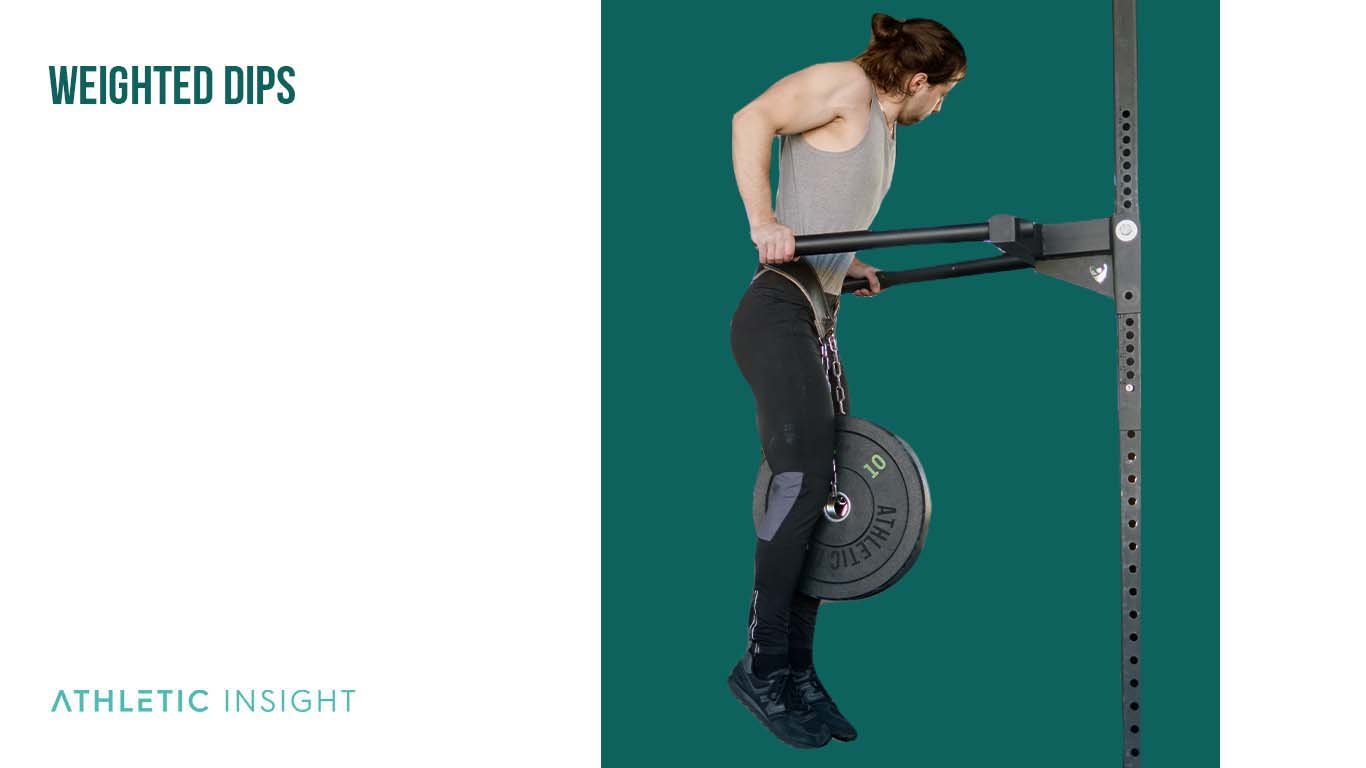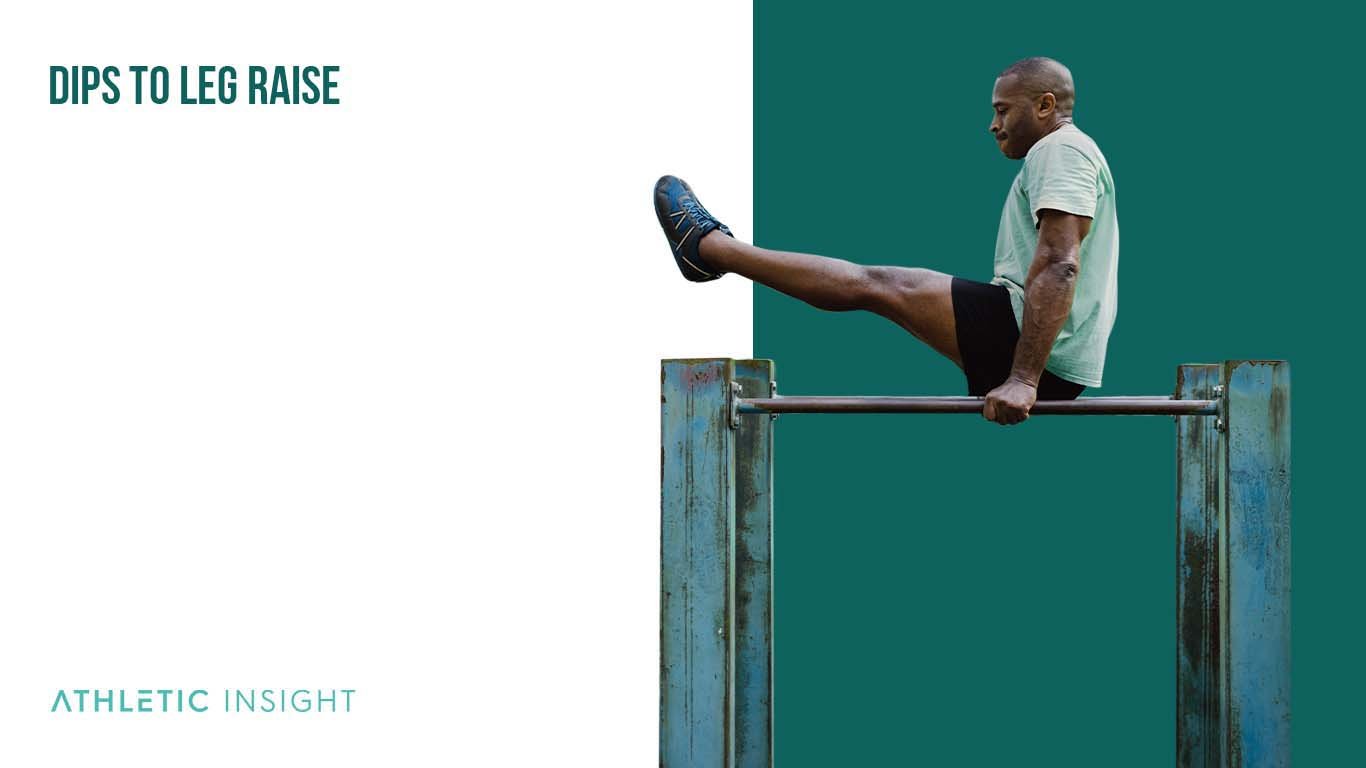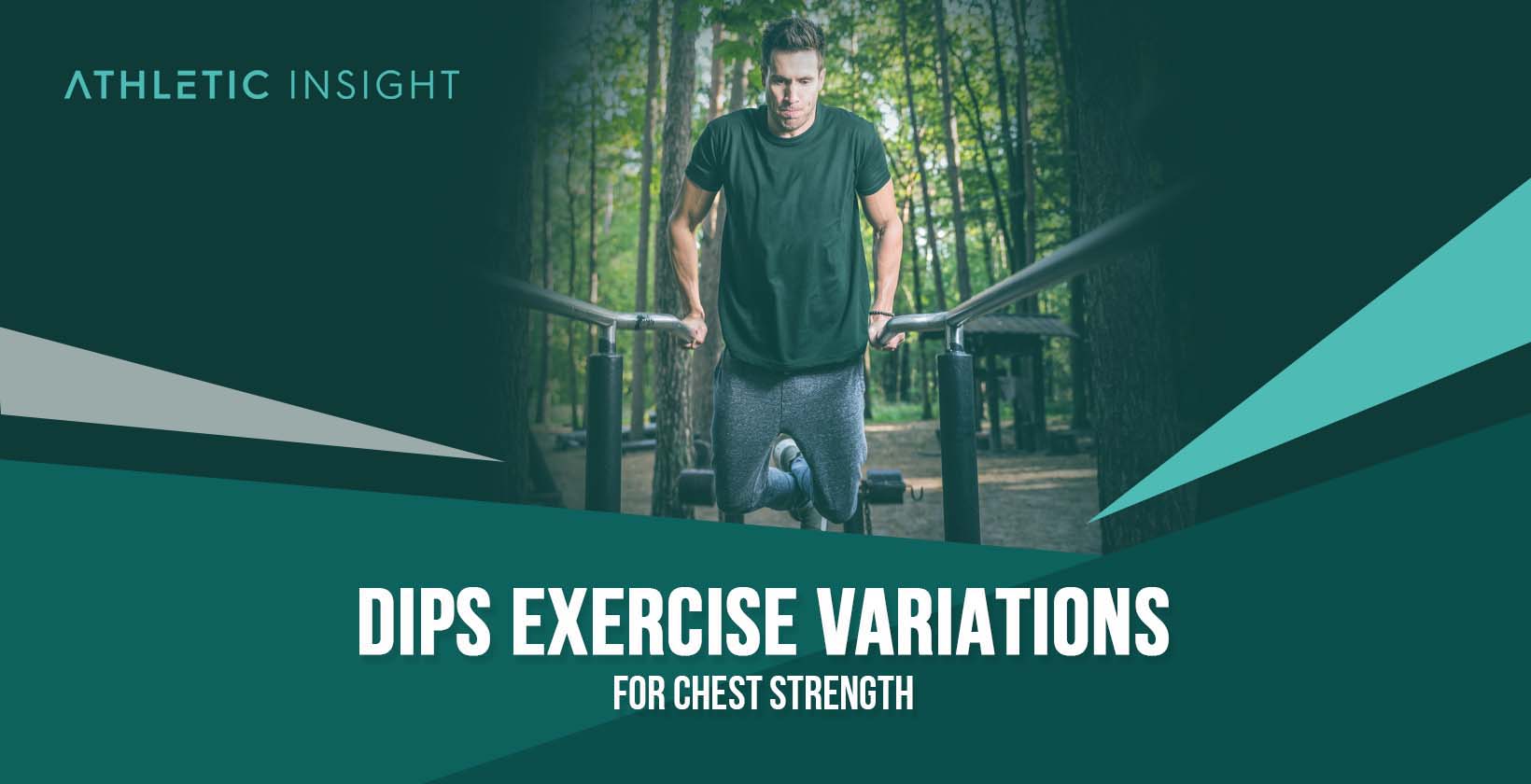Dips are an upper-body strength and toning workout targeting the deltoids, latissimus dorsi, trapezius, biceps brachii, triceps brachii, and brachialis. Dips can be used for athletes who need to build the posterior chain of their upper body after doing excessive pulling motions, such as the pull-up, upright row, and deadlift.
By balancing the posterior and anterior chain of the body, athletes make sure they are well-balanced and can use their force on their back and their chest. Furthermore, this exercise is especially helpful for weightlifters to increase mass, size, and strength in their upper body. Weightlifters who specialize in Olympic lifts will find that the dip helps with shoulder stabilization and upper back strength.
In addition, bodybuilders who want to build the size of their upper back tend to use the dip as a way to improve definition. They are great workouts because they allow you to develop a V-shaped body, stabilize core and back muscles, and have many modifications. Plus, they are among the best exercises for both chest and triceps.
Although dips are classic exercises, you can modify them for a very difficult workout. Many dip variations allow you to add weight. In addition, there are many beginner variations to get you started without injuring yourself. Here are 15 dip variations you can include in your workout routine to improve chest strength.
- Band-assisted Dips
- Jumping Dips with Negatives
- Bench Dips
- Assisted Dips Machine
- Weighted Dips
- Weighted Bench Dips
- Band-Resisted Dips
- Dips to Leg Raise
- Ring Dips
- Side-to-Side Dips
- Bulgarian Dips
- Korean Dips
- Elbow Dips
- One arm dips
- Planche Dips
1. Band-Assisted Dips
Band-assisted dips are an assisted dip variation that focuses on the triceps (triceps brachii) for beginners and experienced athletes hoping to complete more reps. They are best for men and women who are just learning to lift. Many athletes benefit greatly from this triceps and chest exercise.
Make sure that you never take the weight off your triceps, even if your feet touch the floor. Your triceps should be doing all the work to provide the best results.
People will often bend their legs while bracing their glutes and abs, but this causes more spinal movement than necessary.
Band-assisted dips have two different variations that differ in the position of your body. To focus on the triceps, remain upright and pull your elbows close to your body. To focus on the chest, lean forward and spread your elbows.
2. Jumping Dips With Negatives
Jumping dips with negatives is a dip variation that focuses on chest muscles for bodybuilders. These dips are an advanced variation that is geared towards both men and women with strong upper bodies.
For the best performance, use your legs to hop back up when you hit bottom. This keeps the focus on the negatives. Also, make sure that you are lowering yourself slowly so the muscle continues to contract.
Many people give up once they can’t hold the position for 10 seconds, but you should continue until you can’t hold it for 4 seconds.
Jumping dips with negatives have one variation. You can use a weight belt to increase the demand for your pecs, but most people won’t need one.
3. Bench Dips
Bench dips are a dip variation at home that focuses on triceps, chest, and shoulder muscles. They are ideal for beginners. In addition, CrossFit athletes benefit from bench dips for strengthening anterior deltoids.

Make sure you keep your elbows close to the body so that most of the pressure remains on your triceps, not your shoulders. Additionally, move slowly to ensure you are doing all the work and not relying on momentum.
It is common for people to stop before getting low enough. You should continue until your elbow forms a 90-degree angle.
Lastly, bench dips have one variation. To do this variation, bend your knees and pull your feet closer to the elevated surface. This engages the same muscles but to a lesser extent.
4. Assisted Dips Machine
The assisted dips machine is a dip variation that focuses on the triceps for beginners. They are best for men and women that do not have the strength to perform unassisted dips.
To maintain the perfect position and maximize efficacy, keep your eyes looking forward. Perform these dips after a chest press and before fly movements to keep yourself safe and able to perform the best in terms of weight and reps.
Many people are unsure how much weight to add. Remember that adding weight makes these dips easier due to counterbalancing effects.
Assisted dips machine has one variation. By tilting forward, you target the pecs because of the weight shift.
5. Weighted Dips
Weighted dips are weighted triceps variation dips that focus on triceps, chest, shoulders, and arm muscles for weightlifters and bodybuilders. The weighted dip is an effective exercise for both men and women looking to increase upper body strength.

In order to prevent injury, you should only perform weighted dips if you can easily complete ten reps of chest dips. Also, lean forward a bit to ensure that your chest is also engaged.
Be sure to avoid the common mistake of moving your legs. They should be stable so that all of the work is done by your upper body.
Weighted dips have three variations. If it makes you more comfortable, you can use a dumbbell between the ankles, weighted vest, or a backpack full of weights instead of a dip belt and weighted plate.
6. Weighted Bench Dips
Weighted bench dips are a bench dip variation that focuses on the triceps, chest, and shoulders. These dip exercise variations are best suited for men and women, and they are perfect for all athletes.
Lower yourself as low as possible without touching the ground. This maximizes the range of motion and muscles engaged. Also, keep your hands shoulder-width apart to fully engage the triceps.
Often, people try to place the weight on their lap, but this can lead to injury. Have a partner place the weight to prevent injuries.
Weighted bench dips have one variation which is to adjust the amount of weight.
7. Band-Resisted Dips
Band-resisted dips are a dip variation for triceps that focuses on the triceps, chest, and shoulders for weightlifters and bodybuilders.
When you lean forward, be sure to hinge at the hips instead of flexing and rounding your spine. While hinging, flex your hips to stretch the glutes and hamstrings.
Many people don’t use dorsiflexion of the ankles. This should be used to stretch the hamstrings so that you get the most out of the hinge position.
Band-resisted dips have two variations. You can keep your legs straight or bent 90 degrees. The bent leg variation is best for experienced lifters who are used to the hinge.
8. Dips to Leg Raise
Dips to leg raise are a bar dip variation that focuses on the core, hamstrings (subnervabis), hip flexors, and triceps for athletes. They are ideal for young men and women, as well as athletes such as soccer players.

Be sure to raise your feet to waist level to engage the hip flexors. You should hold your feet up for half of a second before lowering them instead of relying on momentum. Remember to lock your arms for these dips.
Dips to leg raise have one variation. By keeping your legs and hips to the side, you can work your obliques.
9. Ring Dips
Ring dips are a ring dip variation that focuses on triceps, chest, and shoulders for mid-level lifters. They are great for men and women aged 40 and up because they are easier on the joints. In addition, gymnasts must perform these quite frequently to excel at their sport.
Although this places less pressure on the joints, it is a complicated exercise. To avoid injury, you should be able to perform stationary dips, static holds, and strict dips first. Additionally, keep your elbows above your wrists when lowering yourself to work the triceps correctly.
Because the rings move, be sure to avoid common injuries by keeping your thumbs turned out slightly. These injuries may result in hand pain and overall joint discomfort.
Ring dips have five variations which are listed below.
- Tempo ring dips to use the full range of motion.
- Elevator ring dips to focus on control and strength building
- Band assisted ring dips for an easier workout
- Leg assisted ring dips to help with stability if needed
- Kipping ring dips to work leg muscles by lifting the legs
10. Side-to-Side Dips
Side-to-side dips are a dip variation that focuses on triceps, shoulder, and chest muscles for intermediate weightlifters. They are ideal for young men and women, as well as most athletes.
While at the top, be sure to keep your elbows extended. When you lower yourself, shift most of your weight to your left triceps, shoulder, and chest.
A common mistake is to rely on muscles from both sides to lift yourself back up because the alternative is more difficult. Don’t perform this exercise unless you can move upward by relying primarily on one side.
Side-to-side dips have two variations. You can alternate sides with each rep or complete one side and then the other. This is a matter of preference.
11. Bulgarian Dips
Bulgarian dips are a dip variation that focuses on pecs (pectoralis major), anterior deltoids, triceps, scapular stabilizers, and core muscles for advanced athletes. They are best for young men, especially those competing in a sport like boxing, which requires strong scapular stabilizers.
You can start even if you can’t lower your arms to 90 degrees, although this should be your goal. Once you reach this goal, you can push the rings outward and point your elbows outward to maximize demand on the pecs.
Many people don’t realize the amount of stability required. Work on your stability over a wide range of motion to improve performance in Bulgarian dips.
Bulgarian dips have one variation. You can decide on tempo demands and pauses to increase time under tension.
12. Korean Dips
Korean dips are a dip variation that focuses on triceps, rotator cuffs (from the Latin word ‘cuffia’), and pecs for athletes. They are best suited for young men and athletes performing in sports such as swimming.
German hangs are excellent stretches to prevent injury and prepare your body before performing these dips. Also, keep your hands close to your body to maximize tension.
Body positioning is an important factor that people frequently overlook at first. When lifting yourself, keep your body bent like a banana so that your body wraps around the bar.
Korean dips have two more difficult variations. The Korean typewriter and Korean archer improve strength, endurance, and mobility by shifting all of the pressure to each arm in turn.
13. Elbow Dips
Elbow dips are a dip variation that focuses on triceps, pecs, core, and back muscles for bodybuilders. It is ideal for young men and women that participate in racket sports.
To avoid injury, only attempt these only if you can perform 15 normal dips. Also, make sure that your movements are controlled when you lean backward.
Many people hurt their elbows during their exercise. Lower your shoulders directly over your hands to keep your weight on the triceps and chest instead of the elbows.
Elbow dips have two variations. For an intermediate workout, use knee-assisted Russian dips. For a beginner workout, keep your feet on the ground.
14. One Arm Dips
One arm dips are a dips variation that focuses on triceps, glutes (musculus glutaeus magnus), and quadriceps for weightlifters. They are best suited for young men and women alike.
Remember to keep your upper arm just above parallel to the floor. Also, point your fingers on the bench laterally away from the body.
Often, people rotate their shoulders and injure themselves. Keep your scapula retracted at all times to avoid this.
One arm dips have one variation. For an easier workout, use both arms to dip.
15. Planche Dips
Planche dips are a dips variation that focuses on triceps, shoulder, and wrist muscles for athletes. It is a suitable workout for athletes such as gymnasts.
These should be done on parallel bars to provide enough space to make your body horizontal. Practice the iron cross and one-arm handstand to prepare for this workout.
Often, people hurt one muscle by working it too often. To balance yourself out and give these muscles a break, pair planche dips with rowing movement exercises.
Planche dips have five variations that build the same muscles and prepare you for planche dips.
- Straddle open tuck hold
- Tuck push back to half straddle
- Tuck push back to open tuck planche
- Tuck push back to single leg planche
- Tuck push back to straddle planche
What to Know About Dips Variations
The following are some facts about dips alternatives.
- Muscle growth: dips alternatives can benefit certain muscle groups better than dips, such as pecs.
- Muscle stability: dips alternatives, such as ring alternatives, can provide more stability practice than dips.
- Range of motion: dips alternatives, such as dips with leg exercises, use a wider range of motion than dips
Variations of the dips can provide benefits that traditional dips cannot. If you are looking for a more comprehensive workout, dips variations are excellent options.
What Are the Common Mistakes in Doing the Dips Variations?
The common mistakes people make when doing dip variations include flaring and locking their elbows, moving too fast, and moving their legs.
Which Type of Dips Variation Is Beginner-Friendly?
Band-assisted dips, assisted dip machines, and bench dips are some of the most beginner-friendly dip variations.
Which Type of Dips Variation Is Good for Weightlifters?
For weightlifters, weighted dips, side-to-side dips, and one arm dips are ideal. These require more weight, allowing them to build their strength.
Which Type of Dips Variation Is Good for Athletes?
Dip variations that are good for athletes are band resisted dips, dips to a leg raise, and Korean dips. Band resisted dips will help build chest strength which is crucial for most athletes. Dips to a leg raise help with hamstrings, and Korean dips help with the rotator cuff.
Which Type of Dips Variation Is Good for Bodybuilders?
For bodybuilders, focusing on jumping dips with negatives and band resisted dips are ideal. Both of these will help because they’re designed to assist bodybuilders in their strength and physique.
What Are the Alternatives of Dips Exercises?
Alternatives of dips are listed below.
- Lying dumbbell triceps extension
- Close grip push up
- Banded one-arm tricep extension
- Overhead band triceps extension



